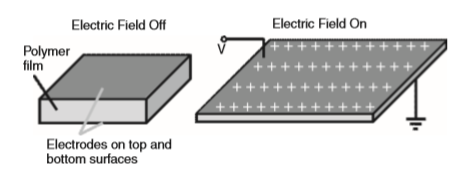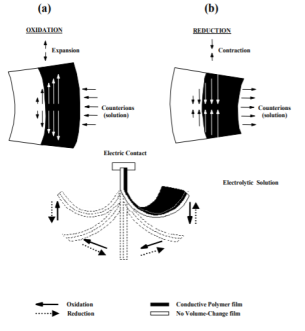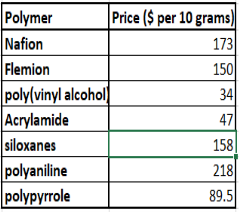Classes of Electroactive Polymer Materials
| ✅ Paper Type: Free Essay | ✅ Subject: Chemistry |
| ✅ Wordcount: 2796 words | ✅ Published: 23rd Sep 2019 |
There are different classes of electroactive polymer materials. There are electronic EAP, ionic EAP, carbon nanotube actuators and conductive polymer actuators.
Recent research work has allowed us to enhance the E-M performance using electroactive polymers. These electroactive polymers have better electro-magnetic performance than crystals and ceramics. This has led to the creation of many devices including actuators, sensors, and transducers. Electric EAPs are further classified into ferroelectric polymers, dielectric EAP, and electro-viscoelastic elastomers. Among the ferroelectric polymer actuators, the most common copolymer is the poly (vinylidene fluoride) or PVDF. These polymers, most commonly used as sheets, have metallic electrodes that increase the stiffness and decrease the piezoelectric response [1]. Key advantages of using a ferroelectric material are that they can be operated in air, vacuum or water and within a wide range of temperatures. Dielectric EAPs are materials in which actuation is caused by electrostatic forces. Dielectric elastomers have a polymer film between two electrodes. As seen in figure 5, when an electric field is induced between the electrodes, the shape of the elastomer changes, which aids in the use of these as actuators. When a dielectric material is subjected to an electric field, positive and negative charges appear on its surfaces. This generates a coulombic force, which in turn generates a stress, which results in a strain response. The most popular type of electric EAP in today’s world, however, is the electro-viscoelastic elastomer. These materials are composite of silicone elastomers and a polar phase. As an electric field is applied to a viscoelastic elastomer, the shear modulus changes. Electric EAPs can operate for long periods of time, with rapid response times. They can also handle high strains if a voltage is applied, however, they require high voltages upwards of 150Mv per m, and have low glass transition temperature, which limits how low the temperature can be [2].

Figure 5: Schematic of the charges and how the shape of the elastomer changes upon an applied current.
Ionic EAPs or Ionic polymer-metal composites are composed of ionic gel polymer planted with metal electrodes. These devices are being researched for their possible use in the field of artificial muscle-like actuators. When you apply a voltage, the cations on the side with the dragging water move, and this results in a pressure gradient for the ionic gel polymer [3]. They are soft materials, that can be molded into almost any shape and can be activated in water. These actuators are used for their low voltage needs, and relatively large responses. As of now there are no working electrically driven gel muscles, however, in light of recent studies and the data collected, it is not far from reality. Few studies have considered using inorganic fibers/ plates in order to reinforce the gels. This results in a significant increase in the modulus. Despite all the positive attributes associated with the ionic EAPs, they are not widely used because of the slow response compared to the other EAPs. It is also important to note that it is hard to produce a consistent material with ionic EAPs. However, their full potential of composites is yet to be fully explored.
 One of the most common EAPs found today are made out of conducting polymers. Conducting polymers belong to family of compounds that are made of monomer units with chemical bonds that under certain conditions such as doping, ensure that there is conductivity in the polymer. As shown in figure 6, when these polymers are grown in the presence of small anions the volume change is a result of stress gradient that is created by the interface during the oxidation or reduction processes [4]. Actuators are made from four main types of conducting polymers. Polypyrrole (PPy), Polyaniline (PANi), Poly(3,4-ethylenedioxythiophene) (PEDOT), and carbon nano tubes are the main types of electroactive polymers that are used as actuators. Shown in figure 7,on the next page, are the chemical structures of the three most commonly used polymers for conducting actuators.
One of the most common EAPs found today are made out of conducting polymers. Conducting polymers belong to family of compounds that are made of monomer units with chemical bonds that under certain conditions such as doping, ensure that there is conductivity in the polymer. As shown in figure 6, when these polymers are grown in the presence of small anions the volume change is a result of stress gradient that is created by the interface during the oxidation or reduction processes [4]. Actuators are made from four main types of conducting polymers. Polypyrrole (PPy), Polyaniline (PANi), Poly(3,4-ethylenedioxythiophene) (PEDOT), and carbon nano tubes are the main types of electroactive polymers that are used as actuators. Shown in figure 7,on the next page, are the chemical structures of the three most commonly used polymers for conducting actuators.
Figure 6: Bending movement of conductive polymer films
According to a study conducted by the journal of physics, PPy or polypyrrole, was the most studied conducting polymer for actuators. The main reason for this is due to it electrodeposition properties. Electrodeposition is a process, also known as electroplating, which is most commonly used to increase corrosion protection and abrasion resistance, as well as to deposit a layer of another material that can help with different properties [5]. In most actuators PPy is used as the additional layer on top of metal electrodes. With voltages ranging from 1-3 V, strain rates ranging from 2 to 30 percent, and high stresses reaching up to 30 MPa, it is the perfect candidate for the use in an actuator. They are also used due to the low power that is needed to output a large amount of steady force[6]. Though PPy exhibits great properties needed for actuators, the formulation of the polymer is rather difficult due to the insolubility in aqueous or organic solutions.
Get Help With Your Essay
If you need assistance with writing your essay, our professional essay writing service is here to help!
Find out more about our Essay Writing Service
Polyaniline, or PANi is the second most studied polymer next to PPy. The main reason for the interest in this polymer is because it is prepared chemically by oxidative polymerization in aqueous acid solutions. This results in easy fabrication of films, and fibers that can be used on the actuators. Due to the acidic nature of the polymer, however, the PANi polymer is avoided despite its ease in production. It was also found that the most stable region for the operation was in the pH4 regime. It is however being research that PANi can be used as microtubes as building blocks for polymer actuators.
One of the most important polymers that is currently being researched however is the PEDOT also known as poly(3,4-ethylenedioxythiophene). This is one of the most widely used polymers in this field due to a variety of applications, such as transparency, high capacitance and conduction, and because of its high stability. Though the polymer contains many properties that are essential for actuators, the toughness of the PEDOT films is much lower than that of PANi films and the PPy films. Despite the lack of strength, PEDOT is still one of the most commonly used polymers in the actuator field, due to its high stability in electrochemical reactions. 
Figure 7: Chemical structures of commonly used electroactive polymers including, PPy, PANi, and PEDOT [7]
Another less common material that is now being researched for actuators is CNT or carbon nanotubes. These materials have excellent electrical and mechanical properties that are derived from their structure. These tubes consist of hollow cylinders of covalently bonded carbon, which is almost one atomic layer thick. They are made using a process called chemical vapor deposition. Chemical vapor deposition is a method used to produce high quality materials typically. This technique helps produce thin films that can then be used for various tasks. This process is used to deposit hydrocarbons over metal catalysts. These tubes are then taken through a filtering process that results in mats of single walled nanotube ropes that are intertwined with each other. This is when certain fluorinated membranes such as polyvinylidene fluoride, are used to prevent strong adhesion between the membrane and the nanotubes themselves. After these mats are created, they are referred to as “Bucky paper”, due to the paper like structure. Single walled carbon nanotubes were shown to generate higher stresses than natural muscle. These materials were shown to have high stiffness, strength and yield strains. Macroscopic natural actuators are made with billions of CNTs. With CNTs, it is also possible to produce large actuator strains with low voltage which makes it a much more desirable material. Direct conversion of electrical energy to mechanical energy through a response is important for actuators [7]. The performance of these tubes depends on their ability to remove charges.
For many years, EAPs were given little attention due to the small amount of viable materials. With the emergence of new materials, and better technologies, they are starting to be researched again. With the wide variety of the different types of polymer actuators, the applications are endless. Since EAP materials can be transformed into various shapes, it makes them very versatile. They can be used in a variety of fields including artificial muscles, tactile displays, and microfluids. One of the most practical, and common application for EAPs is artificial muscles. Over the past few years, many scientists and researchers have discovered the similarities between the electroactive polymers and human muscles. EAPs are highly damage tolerant, resilient, and can be manipulated to produce large actuation strains. These devices can produce forces up to 25 MPa and have actuation strains of over 300 percent [9]. Both these attributes combined with the ability to perform these tasks in less a second, make it a perfect candidate for artificial muscles. Also, the high fracture toughness makes it relatively resilient and aids in the longevity of the product. Electroactive polymers are also recently being researched for refreshable braille displays. Braille is a tactile writing system that is used by visually impaired people [12]. This concept utilizes the basic concept of an EAP actuator. A row of EAP actuators is placed on one side, and a row of electrodes is placed on the other side. A braille dot is placed on all the actuators, and a voltage is applied. The voltage lowers or raises the actuators which results in a braille system that is fast and refreshable.
The EAPs are also used for microfluidics. Microfluidic devices control and manipulate fluids that are restricted into a small capillary. Microfluidics has a variety of application including drug delivery systems. Microfluidic devices use EAPs because of their low fabrication costs, and robustness. In the past few years there are many researches being conducted on siloxanes and its ability to function as a smart material. They are considered ‘smart’ because the shape of a siloxane can be changed very rapidly in the presence of an electric field. When this electric field is converted into mechanical energy, it can be used to move fluids using channeled networks [10]. Electroactive polymers are also promising for the file of drug delivery systems. They are especially useful in “on-off” conditions where the drug release mechanism might need to be controlled while the pharmaceutical ingredients are being released in the body. Common polymers that are used for this include polyaniline, polypyrrole, polythiophene and even polyethylene. These polymers are blended into corresponding hydrogels, with the pharmaceutical compound, which allows you to have a patient-controlled drug delivery system [11].
 The cost of electroactive polymers depends on the intended use. For majority of the electroactive polymers that are used, they can be bought from various retailers and are fairly easy to access. A table of common electroactive polymers, along with their corresponding prices is shown. The prices of the polymers can range between 30 dollars per 10 grams to upwards of 290 dollars per 10 grams, depending on the application [8]. The processing of these polymers is relatively hard and cannot be done with conventional techniques such as extrusion and molding. In some cases, formation of gels is done using irradiation of pre-existing shapes. Another way to do so is using polymerization of monomer solutions[13]. The characterization of the different devices and materials is done according to their properties. While certain polymers such as PPu and PANi are characterized using techniques such as chronopotentiometry, other devices such as nanotubes are characterized using neutron diffraction, and x-ray photoelectron spectroscopy [14]. Using electroactive polymers for actuators is also more environmentally friendly than using other materials. The ease of production, alongside with the low production time makes electroactive polymers a much more viable option.
The cost of electroactive polymers depends on the intended use. For majority of the electroactive polymers that are used, they can be bought from various retailers and are fairly easy to access. A table of common electroactive polymers, along with their corresponding prices is shown. The prices of the polymers can range between 30 dollars per 10 grams to upwards of 290 dollars per 10 grams, depending on the application [8]. The processing of these polymers is relatively hard and cannot be done with conventional techniques such as extrusion and molding. In some cases, formation of gels is done using irradiation of pre-existing shapes. Another way to do so is using polymerization of monomer solutions[13]. The characterization of the different devices and materials is done according to their properties. While certain polymers such as PPu and PANi are characterized using techniques such as chronopotentiometry, other devices such as nanotubes are characterized using neutron diffraction, and x-ray photoelectron spectroscopy [14]. Using electroactive polymers for actuators is also more environmentally friendly than using other materials. The ease of production, alongside with the low production time makes electroactive polymers a much more viable option.
Table 1: Common electroactive polymers and their corresponding prices
Overall there is a wide variety of applications for electroactive polymers including actuators, artificial muscles, tactile displays, as well as microfluid devices. They are relatively cheap and have short production times. There properties, alongside with its production methods make it a viable candidate for a huge array of applications.
References
[1] Anion Exchange Membranes. (n.d.). Retrieved from https://www.fuelcellstore.com/fuel-cell-components/membranes/anion-exchange-membrane?sort=p.price&order=ASC
[2] Bar-Cohen, Y. (2004). Electroactive polymer (EAP) actuators as artificial muscles: Reality, potential, and challenges. Bellingham, WA: SPIE Press.
[3] Carpi, F., & Smela, E. (2009). Biomedical applications of electroactive polymer actuators. Oxford: Wiley-Blackwell.
[4] Cohen, B., Dr. (2010, May). Electroactive Polymers as actuators. Retrieved February 3, 2019, from https://www.sciencedirect.com/topics/chemistry/electroactive-polymers
[5] Electroactive Polymers as Actuators. (2017, June 23). Retrieved from https://www.sciencedirect.com/science/article/pii/B9780081021354000084
[6] Madden, J. D. (1970, January 01). Polypyrrole Actuators: Properties and Initial Applications. Retrieved from https://link.springer.com/chapter/10.1007/978-1-84628-372-7_5
[7] Polsiak, J., Dr, & Lediaev, L., Dr. (n.d.). Actuators based on PVDF sheets with flexible PEDOT polymer electrodes. Retrieved February 17, 2019, from https://ieeexplore.ieee.org/stamp/stamp.jsp?arnumber=1612402
[8] Polypyrrole | Sigma-Aldrich. (n.d.). Retrieved from https://www.sigmaaldrich.com/catalog/search?term=polypyrrole&interface=All&N=0&mode=match partialmax&lang=en®ion=US&focus=product
[9] Price, A. K., Anderson, K. M., & Culbertson, C. T. (2009, July 21). Demonstration of an integrated electroactive polymer actuator on a microfluidic electrophoresis device. Retrieved from https://www.ncbi.nlm.nih.gov/pubmed/19568678
[10] Refreshable Braille Displays. (n.d.). Retrieved from http://www.afb.org/prodBrowseCatResults.aspx?CatID=43
[11] Thummala, P., Huang, L., Zhang, Z., & Andersen, M. A. (2012). Analysis of Dielectric Electro Active Polymer actuator and its high voltage driving circuits. 2012 IEEE International Power Modulator and High Voltage Conference (IPMHVC). doi:10.1109/ipmhvc.2012.6518779
[12] Université du Luxembourg. (n.d.). Electrodeposition. Retrieved February 20, 2019, from https://wwwfr.uni.lu/recherche/fstc/physics_and_materials_science_research_unit/research_areas/photovoltaics/research/electrodeposition
[13] Wang, W., Dr. (n.d.). Electroactive polymers. Lecture. Retrieved February 2, 2019, from https://depts.washington.edu/mictech/optics/sensors/week7.pdf
[14] Kaneto, K. (2016). Research Trends of Soft Actuators based on Electroactive Polymers and Conducting Polymers. Journal of Physics: Conference Series,704, 012004. doi:10.1088/1742-6596/704/1/012004
[15] Boeva, Z. A., & Sergeyev, V. (2014). Polyaniline: Synthesis, properties, and application. Journal of Polymer Science,56(1), 144-153. doi:10.1107/s0108768107031758/bs5044sup1.cif
Cite This Work
To export a reference to this article please select a referencing stye below:
Related Services
View allDMCA / Removal Request
If you are the original writer of this essay and no longer wish to have your work published on UKEssays.com then please click the following link to email our support team::
Request essay removal


